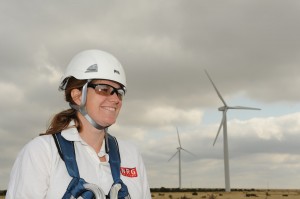April 10, 2012 | Engineering + Technology, Wind Plant Optimization
Every April as the ground thaws, the buds crack open, and the days grow longer, Earth Day arrives with its gentle reminder: “It’s the Planet, Stupid.”
While we toil along – trying to drive less (or not), trying to conserve electricity (or not) – technological evolutions in every sector are helping us do more with less. We know technology alone can’t divert us from the crash course we’re on with the planet’s natural systems. But every once in a while I find inspiration in a techie solution – in the way human ingenuity is improving our odds. Hence this post: a third in a series on improving productivity in the wind industry.
One year ago, Laura Goodfellow, technical sales account manager for NRG Systems, penned an article in North American Windpower: How turbine control sensors can improve turbine performance [.pdf]. As Laura points out, technological advancements in turbine controls have helped wind farm operators produce more power, more of the time. She writes:
For wind farm operators, maximizing return on their existing assets is the name of the game. Whether they are managing new wind farms with state-of-the-art machines or older plants with machines coming off warranty, operators are constantly seeking ways to deliver more power more reliably. At the same time, turbine manufacturers are improving the efficiency and durability of their machines. They are finding ways to produce power at lower wind speeds and in complex environments. Utilities, developers, manufacturers and operators are all demanding the same thing: lower cost, higher performing machines.
From atop the nacelle, turbine control sensors collect data on wind speed and direction, and send that data directly to the controller. This data is used to steer the nacelle into the wind, regulate blade pitch, and control cut-in or cut-out. For example, in extreme winds, turbine control sensors help avert damage by signaling to furl the blades or shut down operation. More on these sensors from Laura:
There are two main types of technology on the market today: mechanical sensors with rotating parts—anemometers and wind vanes—and ultrasonic sensors that measure wind speed and direction using ultrasonic acoustic waves… Ultrasonics provide real-time data and are not vulnerable to inertia (the short lag-time it takes a mechanical sensor to start and stop moving)… Another benefit of ultrasonics is their low thresholds. This is helpful for operators that are trying to eke more power from their machines at low wind speeds. Mechanical sensors have been in use for many years and are considered to be a proven, familiar technology. They work well in rain and are available fully heated or with heated bearings. The design of the sensor is generally more rugged, allowing for easier installation and handling.
Using redundant and complementary turbine control technologies is one way turbine manufacturers and operators optimize energy production and extend the life of their machines. Again, Laura writes:
Redundancy of sensors and the pairing of ultrasonics with mechanicals is a trend that’s likely to continue. It ensures reliable operation of the turbine in case one set fails and allows the operator to take advantage of each technology’s unique benefits. Given the importance of maximizing performance of wind turbines, redundant sensors mounted on the nacelle is critical to minimizing sensor fault conditions.
Okay, I realize turbine control sensors aren’t thrilling in and of themselves, but they’re one solution among many for improving turbine performance; one solution for boosting the supply of clean power; and one more solution for preserving our planet.
This Earth Day, which techie solution do you want to celebrate?
Sources:

